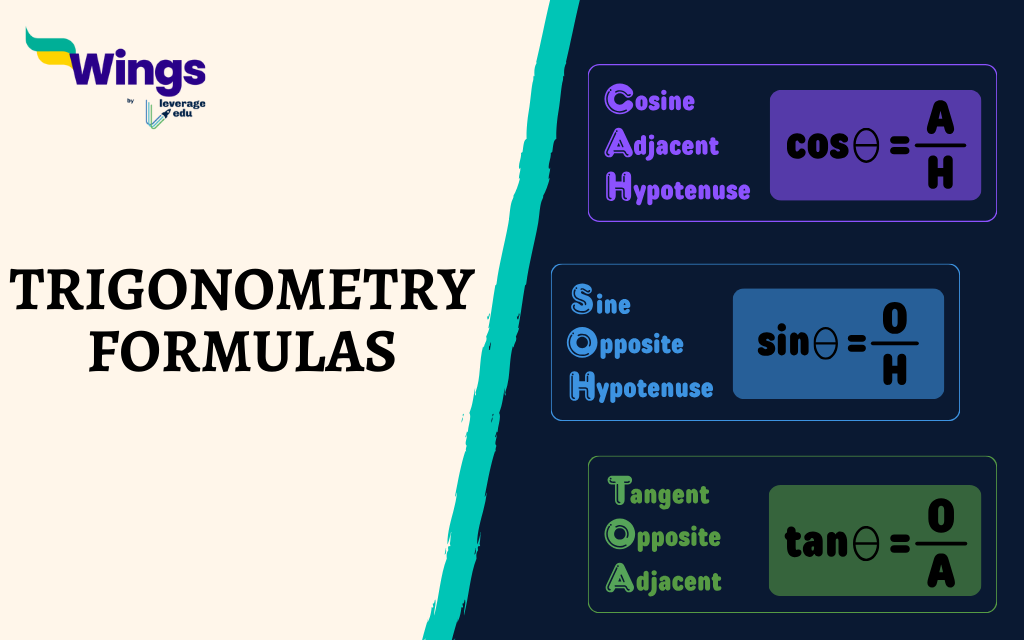Trigonometry is the study of relationships between angles and sides of triangles and is a fundamental branch of mathematics. However, Trigonometry Formulas come into use whilst solving trigonometry problems. Furthermore, these Trigonometry Formulas help with the solutions. Read on to learn more about these important Trigonometry Formulas along with their Examples and Solutions.
Also Read: Introduction to Trigonometry
Contents
Basic Trigonometric Ratio Formulas
The Basic Trigonometric Ratios are sine (sin), cosine (cos), and tangent (tan). Moreover, these Ratios are defined as follows:
- Sine (sin): The ratio of the opposite side to the hypotenuse of a right-angled triangle.
- For Example: In a right-angled triangle with an angle of 30°, if the hypotenuse is 10 units, the opposite side is 5 units.
- Therefore, sin(30°) = 0.5.
- Cosine (cos): The ratio of the adjacent side to the hypotenuse of a right-angled triangle.
- For Example: In the same triangle, the adjacent side is 8.66 units.
- Therefore, cos(30°) = 0.866.
- Tangent (tan): The ratio of the opposite side to the adjacent side of a right-angled triangle.
- For Example: In the same triangle, the tangent of 30° is 0.577, as the opposite side is 5 units and the adjacent side is 8.66 units.
Also Read: 21 Trignometry Formulas for Competitive Exams
Reciprocal Identities
Additionally, the Reciprocal Identities are:
- Cosecant (csc): The reciprocal of sine, csc(x) = 1/sin(x).
- Secant (sec): The reciprocal of cosine, sec(x) = 1/cos(x).
- Cotangent (cot): The reciprocal of tangent, cot(x) = 1/tan(x).
For Example:
If sin(x) = 0.5,
then csc(x) = 1/0.5 = 2.
Also Read: Algebraic Identities: Examples and Chart
Trigonometric Ratio Table
Here is the Trigonometric Ratio Table that provides the values of sine, cosine, and tangent for common angles:
| Trigonometric Ratio Table | |||
| Angle | Sine | Cosine | Tangent |
| 0° | 0 | 1 | 0 |
| 30° | 0.5 | 0.866 | 0.577 |
| 45° | 0.707 | 0.707 | 1 |
| 60° | 0.866 | 0.5 | 1.732 |
| 90° | 1 | 0 | undefined |
For Example: If the angle is 45°, the sine is 0.707, the cosine is 0.707, and the tangent is 1.
Also Read: Trigonometry Formulas for Quantitative Section
Periodic Identities
Moreover, the Periodic Identities describe the repeating patterns of Trigonometric functions:
- sin(x + 2π) = sin(x)
- cos(x + 2π) = cos(x)
- tan(x + π) = -tan(x)
For Example:
If sin(x) = 0.5,
then sin(x + 2π) = 0.5.
Also Read: Order of Operations and PEMDAS Rule
Co-Function Identities
The Co-Function Identities relate the Trigonometric functions of Complementary angles (angles that add up to 90°):
- sin(x) = cos(90° – x)
- cos(x) = sin(90° – x)
- tan(x) = cot(90° – x)
For Example:
If sin(30°) = 0.5,
then cos(60°) = 0.5.
Also Read: Conic Sections
Sum and Difference Identities
The Sum and Difference Identities describe the relationships between Trigonometric functions of the sum or difference of two angles:
- sin(A + B) = sin(A)cos(B) + cos(A)sin(B)
- sin(A – B) = sin(A)cos(B) – cos(A)sin(B)
- cos(A + B) = cos(A)cos(B) – sin(A)sin(B)
- cos(A – B) = cos(A)cos(B) + sin(A)sin(B)
For Example:
If sin(30°) = 0.5 and cos(45°) = 0.707,
then sin(30° + 45°) = 0.5 ✕ 0.707 + 0.866 ✕ 0.707 = 0.866.
Also Read: What is the Difference Between Degrees and Radians?
Half, Double and Triple Identities
These Identities relate the Trigonometric functions of an angle to the functions of Half, Double, or Triple that angle:
- sin(2x) = 2sin(x)cos(x)
- cos(2x) = cos²(x) – sin²(x)
- tan(2x) = 2tan(x) / (1 – tan²(x))
For Example:
If sin(30°) = 0.5,
then sin(60°) = 2 ✕ 0.5 ✕ 0.866 = 0.866.
Sum to Product Identities
The Sum to Product Identities allows the conversion of sums and differences of Trigonometric functions into products:
- sin(A) + sin(B) = 2sin((A+B)/2)cos((A-B)/2)
- sin(A) – sin(B) = 2cos((A+B)/2)sin((A-B)/2)
- cos(A) + cos(B) = 2cos((A+B)/2)cos((A-B)/2)
- cos(A) – cos(B) = -2sin((A+B)/2)sin((A-B)/2)
For Example:
If sin(30°) = 0.5 and sin(45°) = 0.707,
then sin(30°) + sin(45°) = 2 ✕ sin(75°/2) ✕ cos(15°/2) = 0.866 ✕ 0.966 = 0.837.
Also Read: Profit and Loss Formula Questions
Inverse Trigonometry Formulas
The inverse trigonometric functions, denoted as sin^-1, cos^-1, and tan^-1, allow us to find the angle given the value of the trigonometric function:
- sin^-1(x) = the angle whose sine is x
- cos^-1(x) = the angle whose cosine is x
- tan^-1(x) = the angle whose tangent is x
For Example:
If sin(x) = 0.5,
then x = sin^-1(0.5) = 30°.
Also Read: 20 Most Famous Indian Mathematicians
Sine Law
The Sine Law states that the ratio of the length of a side to the sine of the opposite angle is constant for all triangles:
sin(A)/a = sin(B)/b = sin(C)/c
For Example:
In a triangle with sides a = 5, b = 6, and c = 7, and angles A, B, and C, we can use the sine law to find the unknown angle A:
sin(A)/5 = sin(B)/6
sin(A) = (5/6)sin(B)
Also Read: Algebra Questions
Cosine Law
The Cosine Law relates the lengths of the sides of a triangle to the cosine of one of the angles:
c^2 = a^2 + b^2 – 2ab cos(C)
For Example:
In a triangle with sides a = 5, b = 6, and c = 7, we can use the cosine law to find the angle C:
7^2 = 5^2 + 6^2 – 2(5)(6)cos(C)
cos(C) = (5^2 + 6^2 – 7^2) / (2 * 5 * 6) = 0.5
Related Blogs
I hope this helps! Did you like learning about Trigonometry Formulas? Keep reading our blogs to learn more about the Basic Concepts of Maths!
 One app for all your study abroad needs
One app for all your study abroad needs














